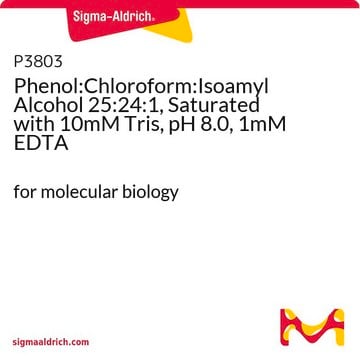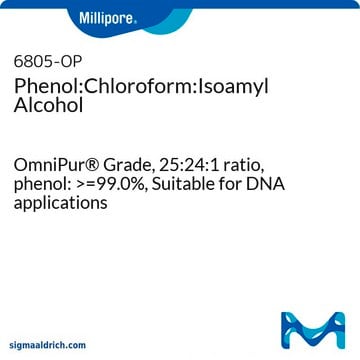The contents of the Tris base are added to the phenol:chloroform:isoamyl alcohol mixture, and the contents are well mixed. The amount added is 6.5 mL equilibration buffer per 100 mL phenol, designed so that only one treatment is necessary to raise the pH. Allow the mixture to separate, which may take 2-4 hours. The upper aqueous phase is removed and discarded. The remaining lower organic phase is divided into aliquots and stored at -20 °C. The solution should be stable for up to 12 months. The pH of the phenol should be raised from 6.7 to about 7.9-8. Only one treatment is needed.
P2069
Phénol:Chloroform:Alcool isoamylique 25:24:1 saturé avec 10 mM Tris, pH 8,0, 1 mM EDTA
Supplied with Equilibration buffer, for molecular biology
Synonyme(s) :
DNA extraction
Sélectionner une taille de conditionnement
176,00 €
Sélectionner une taille de conditionnement
About This Item
176,00 €
Produits recommandés
Qualité
Molecular Biology
for molecular biology
Niveau de qualité
Essai
≥99.0%
Forme
liquid
pH
6.5-6.9(pH of phenolic phase)
7.8-8.2(pH of phenolic phase after the addition of Equilibration Buffer)
Application(s)
agriculture
Température de stockage
2-8°C
Application
Conditionnement
Adéquation
Notes préparatoires
Autres remarques
Produit(s) apparenté(s)
Mention d'avertissement
Danger
Mentions de danger
Classification des risques
Acute Tox. 3 Oral - Acute Tox. 4 Dermal - Acute Tox. 4 Inhalation - Aquatic Chronic 2 - Carc. 2 - Eye Dam. 1 - Muta. 2 - Repr. 2 - Skin Corr. 1B - STOT RE 1 Oral - STOT RE 2 - STOT SE 3
Organes cibles
Central nervous system, Liver,Kidney, Nervous system,Kidney,Liver,Skin
Code de la classe de stockage
6.1A - Combustible acute toxic Cat. 1 and 2 / very toxic hazardous materials
Classe de danger pour l'eau (WGK)
WGK 3
Point d'éclair (°F)
Not applicable
Point d'éclair (°C)
Not applicable
Listes réglementaires
Les listes réglementaires sont principalement fournies pour les produits chimiques. Seules des informations limitées peuvent être fournies ici pour les produits non chimiques. L'absence d'indication signifie qu'aucun des composants n'est répertorié. Il incombe à l'utilisateur de s'assurer de l'utilisation sûre et légale du produit.
EU REACH Annex XVII (Restriction List)
Faites votre choix parmi les versions les plus récentes :
Déjà en possession de ce produit ?
Retrouvez la documentation relative aux produits que vous avez récemment achetés dans la Bibliothèque de documents.
Les clients ont également consulté
Protocoles
Method for reverse transcription of RNA into DNA. Uses a premixed reagent that contains reverse transcriptase, dNTPs, primers, RNase inhibitor and buffer. Fast generation of cDNA.
-
Hello, I used P2069 for DNA extraction from mouse tails. After adding the equilibration buffer, I wait for 2~4hrs until phase seperation. At this point, I have a question. I heard that lower phase is the phase I utilize, so Can I aliquot the lower phase?
1 answer-
Helpful?
-
-
Hello, I used this material for DNA extraction from mouse tail. After mixing the equilibration buffer, there was two phase. Which phase should I use? Also, Can I aliquot the liquid?
1 answer-
The lower phase should be used for DNA extraction. It is possible to aliquot the liquid immediately after mixing, before the phases separate.
Helpful?
-
-
After equilibrating with the supplied Tris buffer, can I aliquot this for use, if so, should I just top each aliquot with additional Tris pH 8?
1 answer-
Please see the link below to review the product datasheet. Note that the prepration instructions require the addition of the entire vial (6.5 mL) of equilabration buffer to the contents of the product. Aliquot immediately after the gentle mixing step. During the 2 - 4 hour incubation period the mixure will phase separate. At this point the aliquots may be stored for long term use according to the instructions.
https://www.sigmaaldrich.com/deepweb/assets/sigmaaldrich/product/documents/144/892/p2069dat.pdfHelpful?
-
-
There is an Equilibration Buffer (Product B5658) that is included with Product P2069, Phenol:Chloroform:Isoamyl Alcohol 25:24:1. Is B5658 also available separately?
1 answer-
No, it is only available as part of P2069.
Helpful?
-
-
I see that you list two equilibrated Phenol:Chloroform:Isoamyl alcohol products. When should I use Product P3803, and when should I use Product P2069?
1 answer-
In short, P3803 is for RNA work, and P2069 is for DNA work. Product P2069 consists of one bottle of Product P3803 and one bottle of Product B5658. The B5658 is added to the P3803 to raise the pH of the organic phase from 6.7 to 8.0; pH 8.0 is not suitable for RNA work, because RNA can degrade at the higher pH.
Helpful?
-
-
I ordered Product P2069, Phenol:Chloroform:Isoamyl Alcohol 25:24:1; I got one bottle of the Phenol:Chloroform:Isoamyl Alcohol and one bottle of B5658, Equilibration buffer. When and how am I supposed to use the B5658?
1 answer-
B5658 is a Tris buffer that is used to raise the pH of the phenol:chloroform:isoamyl alcohol mixture, to make it suitable for isolation of genomic DNA. The contents of the two bottles need to be well mixed. Then allow the mixture to separate; this may take 2-4 hours. This procedure should raise the pH of the phenol phase from 6.7 to about 8.0. Only one "treatment" is needed. This solution should be stable for up to 12 months.
Helpful?
-
-
What is the Department of Transportation shipping information for this product?
1 answer-
Transportation information can be found in Section 14 of the product's (M)SDS.To access the shipping information for this material, use the link on the product detail page for the product.
Helpful?
-
-
There are two layers in the bottle of Product P2069, Phenol:Chloroform:Isoamyl Alcohol 25:24:1; which layer should I use?
1 answer-
The lower phase is the phase that is to be used.
Helpful?
-
Active Filters
Notre équipe de scientifiques dispose d'une expérience dans tous les secteurs de la recherche, notamment en sciences de la vie, science des matériaux, synthèse chimique, chromatographie, analyse et dans de nombreux autres domaines..
Contacter notre Service technique













